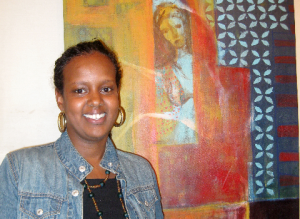
 |
| Artist Deqa Abshir in front of 'Kafia's Caution'
|
Using the silkscreen images superimposed on an acrylic backdrop, Abshir’s current exhibition “Gates”, at the Italian Institute of Culture in Nairobi, showcases 20 new works, all of which feature a pensive Somali woman, either standing or sitting, naked or half-dressed, close by the swirly, ornate grills of a certain style of gate prevalent on this side of the world.
Branded by clear-cut, minimal forms and figures, the images have a template quality about them. Semi- geometric patterns in bright contrasting colours give the feeling of a cut-out collage decorated in ink stamps and stencil drawing.
Like “Warsan’s Gateway”and “Samantha’s Seat”, each title consists of a traditional name, from Somali folklore, and a detail about where each woman is posed.
Conscientious and thoughtful, Deqa Abshir speaks about her work. A Somali born in Kenya, she has been exploring the idea of identity. Is it rooted in our nationality, where we live, who our strongest influences are, what our ancestors did or is it our design entirely? “What you see here is a patchwork,” she begins, “Through feeding off nostalgia, of all the stories I hear about Somalia, I’m building an identity. Living in a different country, in Kenya, I’m trying to weave it all together.”
With a supportive mom proud in the crowd on opening night, Abshir tells us that women have been a strong influence in her life. “My mother protected me and also told me all kinds of stories about where I am from,” she shares.
In 2006, Abshir graduated from Hunter’s College in New York with a double major in Studio Art (concentration in painting) and Women’s Studies.
She has found a way to combine her passions. Her current work focuses specifically on what identity means to women. Through her artwork, she explores the role of woman as both storyteller and guardian of the family unit.
“The Tower of Elba” reveals a Somali woman, Elba, naked except for a red necklace. She stands in front of the image of a minaret, an architectural design of Muslim influence, quite prevalent in Somalia.
There’s a faded gate by her side and another minaret in the backdrop. The colour is particularly powerful. Somalia’s warm oranges, yellows and browns, its sunlight and fever, are juxtaposed with cerulean blues and hints of stark white from a cool, wistful reverie.
Abshir’s painting “Kafia’s Caution” discloses a ghostly woman in a brassiere looking out of an arch window. Also blue, she carries an expression that is at once morose and elegiac.
Like these, Abshir’s works unveil an introspective woman in an illusory atmosphere. Somewhat nebulous, a small excerpt from her biography on the main table tells us, “Her artwork endeavours to highlight the juxtapositions between the realistic and the poetic, the traditional and the modern, the global south and the global north.” We get a slightly clearer and certainly more eloquent description of the message she hopes to convey when we ask Deqa Abshir personally about her use of the gate symbol.
“So why gates?” I ask, to which she responds articulately, almost poetically. “The gate is the most interesting of symbols. It represents restrictions of identity and culture but also protection and new starts.” Subtly hinting at the religious propaganda perpetuated in Somalia, Abshir alludes to the positive aspects of Somali culture. For her, there’s a strong dichotomy. She has enjoyed how women have protected the collective family and other interesting elements of Somali tradition.
It was revitalising to witness Abshir’s positive outlook. The skeptics call it naivety, but realists today have learned that through focusing on your ambition, you can surely design your reality.
With a great turn out on opening night on November 8 and some red stickers on the wall, Abshir is evidence that there are patrons of the art in Kenya looking to support new talent.
If Dega Abshir, who identifies equally with Somali and Kenyan ways, continues to investigate her world and refine her genius, diligently persevering in her practice, she will reach her potential. That’s the way. 'Gates' by Deqa Abshir will close on November 22
No comments:
Post a Comment